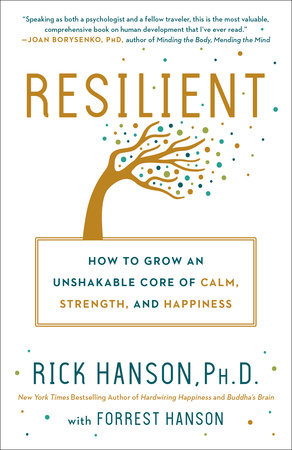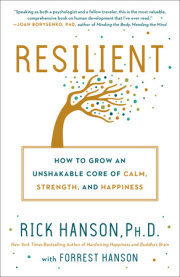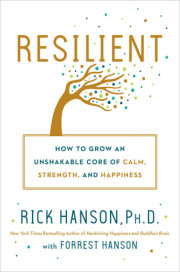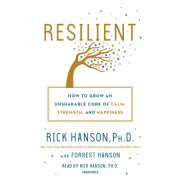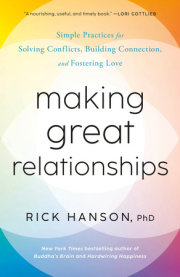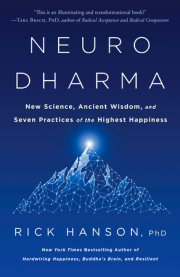Chapter 1Compassion
If I am not for myself, then who will be for me? If not now, when? —Rabbi Hillel
One of the most important experiences of my life happened when I was six years old. My family lived in Illinois, on the edge of cornfields. I remember standing outside early one evening, looking down at the rainwater in the ruts left by tractors, and then looking back at our house. I felt wistful and sad about the anger inside it. There were lights twinkling in the distant hills, the homes of other, perhaps happier families.
As an adult today, I can see that my parents were loving, decent people dealing with their own stresses, and that my childhood was fortunate in many ways. My dad had a tough job and my mom had her hands full with my sister and me. I don’t remember what happened in our home that night. It could have been an ordinary argument. But as if it were yesterday, I remember feeling a caring toward myself. I felt bad, those feelings mattered, and I wanted to help myself feel better. Many years later, I learned that this was compassion—the recognition of pain with the desire to relieve it--which can be given to oneself much as it can be given to others.
I clearly recall knowing that it would be up to me to get through the time ahead, and to find those lights and those people and that greater happiness. I loved my parents and wasn’t against anyone. But I was for myself. I was determined—as a child can be, and an adult as well—to have as good a life as I could.
My own path of well-being began with compassion, as it does for most people. Compassion for yourself is fundamental, since if you don’t care how you feel and want to do something about it, it’s hard to make an effort to become happier and more resilient. Compassion is both soft and muscular. For example, studies show that when people feel compassion, motor planning areas in the brain begin preparing for action.
Compassion is a psychological resource, an inner strength. In this chapter, we’ll explore how to grow compassion and use it for yourself, and in later chapters, we’ll see how to bring compassion to others.
Be for YourselfWhen we treat others with respect and caring, the best in them usually comes out. Much the same would happen if we could treat ourselves the same way.
Yet most of us are a better friend to others than we are to ourselves. We care about their pain, see positive qualities in them, and treat them fairly and kindly. But what kind of friend are you to yourself? Many people are tough on themselves, critical, second-guessing and self-doubting, tearing down rather than building up.
Imagine treating yourself like you would a friend. You’d be encouraging, warm, and sympathetic, and you’d help yourself heal and grow. Think about what a typical day would be like if you were on your own side. What would it feel like to appreciate your good intentions and good heart, and be less self-critical?
Why It’s Good to Be Good to YourselfIt helps to understand the reasons it’s both fair and important to be on your own side. Otherwise, beliefs like these can take over: “It’s selfish to think about what you want.” “You don’t deserve love.” “Deep down you’re bad.” “You’ll fail if you dream bigger dreams.”
First, there’s the general principle that we should treat people with decency and compassion. Well, “people” includes the person who wears your name tag. The Golden Rule is a two-way street: we should do unto ourselves as we do unto others.
Second, the more influence we have over someone, the more responsibility we have to treat them well. For example, surgeons have great power over their patients, so they have a great duty to be careful when they operate on them. Who’s the one person you can affect the most? It’s yourself, both you in this moment and your future self: the person you will be in the next minute, week, or year. If you think of yourself as someone to whom you have a duty of care and kindness, what might change in how you talk to yourself, and in how you go about your day?
Third, being good to yourself is good for others. When people increase their own well-being, they usually become more patient, cooperative, and caring in their relationships. Think about how it would benefit others if you felt less stressed, worried, or irritated, and more peaceful, contented, and loving.
You can take practical steps to help yourself really believe that it’s good to treat yourself with respect and compassion. You could write down simple statements—such as “I am on my own side” or “I’m taking a stand for myself” or “I matter, too”—and read them aloud to yourself or put them somewhere you’ll see each day. You could imagine telling someone why you are going to take better care of your own needs. Or imagine a friend, a mentor, or even your fairy godmother telling you to be on your own side--and let them talk you into it!
The Feeling of Caring for YourselfWhen I left home for UCLA in 1969, I was hyper-rational and stuck in my head. This was a way to avoid feeling sad, hurt, and worried, but then I didn’t feel much of anything at all. I had to get in touch with myself in order to heal and grow. California in the 1970s was at the center of the human potential movement, and I dove in even though it seemed kind of freaky. (Primal screaming! Encounter groups! Bare your soul on demand!) I gradually learned to tune into my emotions and body sensations in general. In particular, I started paying attention to what it felt like to get on my own side, and to have warmth and support toward myself instead of coldness and criticism. It felt good to do this, so I kept doing it. Each time I focused on these positive experiences was like working a muscle and strengthening it, again and again. With repetition, kindness and encouragement for myself gradually sank in and became a natural way of being.
Many years later as a psychologist, I learned how my intuitive efforts had worked. Focusing on and staying with any experience of a psychological resource—such as the sense of being for yourself--is a powerful way to reinforce it in your brain. Then you take that inner strength with you wherever you go.
In the chapters on Mindfulness and Learning, I’ll explain in detail how to turn your thoughts and feelings into lasting strengths inside: the basis of true resilience. The essence is simple: first, experience what you want to develop in yourself—such as compassion or gratitude—and second, focus on it and keep it going to increase its consolidation in your nervous system.
This is the fundamental process of positive brain change. To get a sense of it, try the practice in the box. It takes only a minute or two, or you can slow it down for a deeper effect. Like anything I suggest, adapt it to your own needs. Additionally, in the flow of everyday life, notice when you have an attitude or feeling of caring for yourself, and then stay with the experience for a few extra moments, feeling it in your body, sinking into it as it sinks into you.
Being for YourselfBring to mind a time when you were on somebody’s side: perhaps a child you were protecting, a friend you were encouraging, or an aging parent with health issues. Recall what this felt like in your body—in the set of your shoulders, in the expression on your face. Recall some of your thoughts and feelings—perhaps caring, determination, even a fierce intensity.
Then, knowing what it’s like to be on someone’s side, apply this attitude to yourself. Get a sense of being an ally to yourself—someone who will look out for you, help you, protect you. Recognize that you have rights and needs that matter.
It’s normal if other reactions come up, such as feeling unworthy. Just notice and disengage from them, and then come back to the sense of wishing yourself well. Focus on this experience, and stay with it for a couple breaths or longer.
Bring to mind times when you were really on your own side. Perhaps you were encouraging yourself during a tough period at work or speaking up to someone who hurt you. Get a sense of what that was like, emotionally and in your body. Remember some of the thoughts you had, such as “It’s only fair for others to help, too.” Stay with this experience and let it fill your mind.
Know what it’s like to be committed to your own well-being. Let the feelings, thoughts, and intentions of being a true friend to yourself sink in, becoming a part of you.
Copyright © 2018 by Rick Hanson, Ph.D.. All rights reserved. No part of this excerpt may be reproduced or reprinted without permission in writing from the publisher.

